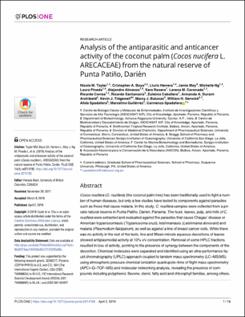Analysis of the antiparasitic and anticancer activity of the coconut palm (Cocos nucifera L. ARECACEAE) from the natural reserve of Punta Patiño, Darién
Fecha
2019-04-02Autor
Tayler, Nicole M.
Boya, Cristopher A.
Herrera, Liuris
Moy, Jamie
Ng, Michelle
Pineda, Laura
Almanza, Alejandro
Rosero, Sara
Coronado, Lorena M.
Correa, Ricardo
Santamaría, Ricardo
Caballero, Zuleima
Durant-Archibold, Armando A.
Tidgewell, Kevin J.
Balunas, Marcy J.
Gerwick, William H.
Spadafora, Alida
Gutiérrez, Marcelino
Spadafora, Carmenza
Metadatos
Mostrar el registro completo del ítemResumen
Cocos nucifera (C. nucifera) (the coconut palm tree) has been traditionally used to fight a number of human diseases, but only a few studies have tested its components against parasites such as those that cause malaria. In this study, C. nucifera samples were collected from a private natural reserve in Punta Patiño, Darien, Panama. The husk, leaves, pulp, and milk of C. nucifera were extracted and evaluated against the parasites that cause Chagas’ disease or American trypanosomiasis (Trypanosoma cruzi), leishmaniasis (Leishmania donovani) and malaria (Plasmodium falciparum), as well as against a line of breast cancer cells. While there was no activity in the rest of the tests, five and fifteen-minute aqueous decoctions of leaves showed antiplasmodial activity at 10% v/v concentration. Removal of some HPLC fractions resulted in loss of activity, pointing to the presence of synergy between the components of the decoction. Chemical molecules were separated and identified using an ultra-performance liquid chromatography (UPLC) approach coupled to tandem mass spectrometry (LC–MS/MS) using atmospheric pressure chemical ionization quadrupole–time of flight mass spectrometry (APCI–Q–TOF–MS) and molecular networking analysis, revealing the presence of compounds including polyphenol, flavone, sterol, fatty acid and chlorophyll families, among others.

